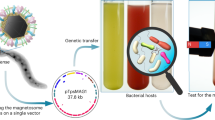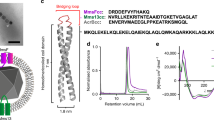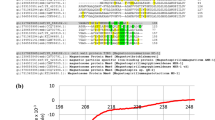Abstract
The synthetic production of monodisperse single magnetic domain nanoparticles at ambient temperature is challenging1,2. In nature, magnetosomes—membrane-bound magnetic nanocrystals with unprecedented magnetic properties—can be biomineralized by magnetotactic bacteria3. However, these microbes are difficult to handle. Expression of the underlying biosynthetic pathway from these fastidious microorganisms within other organisms could therefore greatly expand their nanotechnological and biomedical applications4,5. So far, this has been hindered by the structural and genetic complexity of the magnetosome organelle and insufficient knowledge of the biosynthetic functions involved. Here, we show that the ability to biomineralize highly ordered magnetic nanostructures can be transferred to a foreign recipient. Expression of a minimal set of genes from the magnetotactic bacterium Magnetospirillum gryphiswaldense resulted in magnetosome biosynthesis within the photosynthetic model organism Rhodospirillum rubrum. Our findings will enable the sustainable production of tailored magnetic nanostructures in biotechnologically relevant hosts and represent a step towards the endogenous magnetization of various organisms by synthetic biology.
This is a preview of subscription content, access via your institution
Access options
Subscribe to this journal
Receive 12 print issues and online access
$259.00 per year
only $21.58 per issue
Buy this article
- Purchase on Springer Link
- Instant access to full article PDF
Prices may be subject to local taxes which are calculated during checkout



Similar content being viewed by others
References
Prozorov, T., Bazylinski, D. A., Mallapragada, S. K. & Prozorov, R. Novel magnetic nanomaterials inspired by magnetotactic bacteria: topical review. Mater. Sci. Eng. R 74, 133–172 (2013).
Baumgartner, J., Bertinetti, L., Widdrat, M., Hirt, A. M. & Faivre, D. Formation of magnetite nanoparticles at low temperature: from superparamagnetic to stable single domain particles. PLoS ONE 8, e57070 (2013).
Bazylinski, D. A. & Frankel, R. B. Magnetosome formation in prokaryotes. Nature Rev. Microbiol. 2, 217–230 (2004).
Goldhawk, D. E., Rohani, R., Sengupta, A., Gelman, N. & Prato, F. S. Using the magnetosome to model effective gene-based contrast for magnetic resonance imaging. Wiley Interdiscip. Rev. Nanomed. Nanobiotechnol. 4, 378–388 (2012).
Murat, D. Magnetosomes: how do they stay in shape? J. Mol. Microbiol. Biotechnol. 23, 81–94 (2013).
Lohsse, A. et al. Functional analysis of the magnetosome island in Magnetospirillum gryphiswaldense: the mamAB operon is sufficient for magnetite biomineralization. PLoS ONE 6, e25561 (2011).
Pollithy, A. et al. Magnetosome expression of functional camelid antibody fragments (nanobodies) in Magnetospirillum gryphiswaldense. Appl. Environ. Microbiol. 77, 6165–6171 (2011).
Staniland, S. et al. Controlled cobalt doping of magnetosomes in vivo. Nature Nanotech. 3, 158–162 (2008).
Jogler, C. & Schüler, D. Genomics, genetics, and cell biology of magnetosome formation. Annu. Rev. Microbiol. 63, 501–521 (2009).
Ullrich, S., Kube, M., Schübbe, S., Reinhardt, R. & Schüler, D. A hypervariable 130-kilobase genomic region of Magnetospirillum gryphiswaldense comprises a magnetosome island which undergoes frequent rearrangements during stationary growth. J. Bacteriol. 187, 7176–7184 (2005).
Raschdorf, O., Müller, F. D., Pósfai, M., Plitzko, J. M. & Schüler, D. The magnetosome proteins MamX, MamZ and MamH are involved in redox control of magnetite biomineralization in Magnetospirillum gryphiswaldense. Mol. Microbiol. 89, 872–886 (2013).
Murat, D., Quinlan, A., Vali, H. & Komeili, A. Comprehensive genetic dissection of the magnetosome gene island reveals the step-wise assembly of a prokaryotic organelle. Proc. Natl Acad. Sci. USA 107, 5593–5598 (2010).
Schübbe, S. et al. Transcriptional organization and regulation of magnetosome operons in Magnetospirillum gryphiswaldense. Appl. Environ. Microbiol. 72, 5757–5765 (2006).
Fu, J. et al. Efficient transfer of two large secondary metabolite pathway gene clusters into heterologous hosts by transposition. Nucleic Acids Res. 36, e113 (2008).
Martinez-Garcia, E., Calles, B., Arevalo-Rodriguez, M. & de Lorenzo, V. pBAM1: an all-synthetic genetic tool for analysis and construction of complex bacterial phenotypes. BMC Microbiol. 11, 38 (2011).
Richter, M. et al. Comparative genome analysis of four magnetotactic bacteria reveals a complex set of group-specific genes implicated in magnetosome biomineralization and function. J. Bacteriol. 189, 4899–4910 (2007).
Jogler, C. et al. Conservation of proteobacterial magnetosome genes and structures in an uncultivated member of the deep-branching Nitrospira phylum. Proc. Natl Acad. Sci. USA 108, 1134–1139 (2011).
Lefèvre, C. T. et al. Monophyletic origin of magnetotaxis and the first magnetosomes. Environ. Microbiol. 15, 2267–2274 (2013).
Schüler, D. R., Uhl, R. & Bäuerlein, E. A simple light scattering method to assay magnetism in Magnetospirillum gryphiswaldense. FEMS Microbiol. Ecol. 132, 139–145 (1995).
Uebe, R. et al. The cation diffusion facilitator proteins MamB and MamM of Magnetospirillum gryphiswaldense have distinct and complex functions, and are involved in magnetite biomineralization and magnetosome membrane assembly. Mol. Microbiol. 82, 818–835 (2011).
Scheffel, A. et al. An acidic protein aligns magnetosomes along a filamentous structure in magnetotactic bacteria. Nature 440, 110–114 (2006).
Rong, C. et al. Ferrous iron transport protein B gene (feoB1) plays an accessory role in magnetosome formation in Magnetospirillum gryphiswaldense strain MSR-1. Res. Microbiol. 159, 530–536 (2008).
Grünberg, K. et al. Biochemical and proteomic analysis of the magnetosome membrane in Magnetospirillum gryphiswaldense. Appl. Environ. Microbiol. 70, 1040–1050 (2004).
Lang, C. & Schüler, D. Expression of green fluorescent protein fused to magnetosome proteins in microaerophilic magnetotactic bacteria. Appl. Environ. Microbiol. 74, 4944–4953 (2008).
Jogler, C. et al. Comparative analysis of magnetosome gene clusters in magnetotactic bacteria provides further evidence for horizontal gene transfer. Environ. Microbiol. 11, 1267–1277 (2009).
Jogler, C. et al. Toward cloning of the magnetotactic metagenome: identification of magnetosome island gene clusters in uncultivated magnetotactic bacteria from different aquatic sediments. Appl. Environ. Microbiol. 75, 3972–3979 (2009).
Nishida, K. & Silver, P. A. Induction of biogenic magnetization and redox control by a component of the target of rapamycin complex 1 signaling pathway. PLoS Biol. 10, e1001269 (2012).
Kim, T., Moore, D. & Fussenegger, M. Genetically programmed superparamagnetic behavior of mammalian cells. J. Biotechnol. 162, 237–245 (2012).
Murat, D. et al. The magnetosome membrane protein, MmsF, is a major regulator of magnetite biomineralization in Magnetospirillum magneticum AMB-1. Mol. Microbiol. 85, 684–699 (2012).
Huang, H., Delikanli, S., Zeng, H., Ferkey, D. M. & Pralle, A. Remote control of ion channels and neurons through magnetic-field heating of nanoparticles. Nature Nanotech. 5, 602–606 (2010).
Westmeyer, G. G. & Jasanoff, A. Genetically controlled MRI contrast mechanisms and their prospects in systems neuroscience research. Magn. Reson. Imaging 25, 1004–1010 (2007).
Sambrook, J. & Russell, D. Molecular Cloning: A Laboratory Manual Vol. 3 (Cold Spring Harbor Laboratory Press, 2001).
Kolinko, I., Jogler, C., Katzmann, E. & Schüler, D. Frequent mutations within the genomic magnetosome island of Magnetospirillum gryphiswaldense are mediated by RecA. J. Bacteriol. 193, 5328–5334 (2011).
Acknowledgements
This work was supported by the Human Frontier Science Foundation (grant RGP0052/2012), the Deutsche Forschungsgemeinschaft (grants SCHU 1080/12-1 and 15-1) and the European Union (Bio2MaN4MRI). The authors thank F. Kiemer for expert help with iron measurements and cultivation experiments.
Author information
Authors and Affiliations
Contributions
I.K., D.S., Y.Z., Q.T., C.J. and R.M. planned and performed cloning experiments. I.K. and A.L. performed genetic transfers and cultivation experiments. G.W. prepared cryo- and chemically fixed cells. S.B., O.R. and G.W. performed TEM and I.K. analysed the data. J.P. and O.R. performed cryo-electron tomography experiments. E.T. and M.P. took high-resolution TEM micrographs and analysed the data. I.K. and A.L. took fluorescence micrographs and performed phenotypization experiments. I.K. performed western blot experiments and analysed proteomic data. A.B. performed Illumina genome sequencing and I.K. analysed the data. I.K. and D.S. designed the study and wrote the paper. All authors discussed the results and commented on the manuscript.
Corresponding authors
Ethics declarations
Competing interests
I.K. and D.S. (LMU Munich) have filed a patent application on the process described in this work (Production of magnetic nanoparticles in recombinant host cells, EP13193478).
Supplementary information
Supplementary information
Supplementary Information (PDF 2901 kb)
Rights and permissions
About this article
Cite this article
Kolinko, I., Lohße, A., Borg, S. et al. Biosynthesis of magnetic nanostructures in a foreign organism by transfer of bacterial magnetosome gene clusters. Nature Nanotech 9, 193–197 (2014). https://doi.org/10.1038/nnano.2014.13
Received:
Accepted:
Published:
Issue Date:
DOI: https://doi.org/10.1038/nnano.2014.13
This article is cited by
-
Exploring the host range for genetic transfer of magnetic organelle biosynthesis
Nature Nanotechnology (2024)
-
Synthetic brochosomes: design, synthesis, and applications
Nano Research (2024)
-
Silent gene clusters encode magnetic organelle biosynthesis in a non-magnetotactic phototrophic bacterium
The ISME Journal (2023)
-
The transcriptomic landscape of Magnetospirillum gryphiswaldense during magnetosome biomineralization
BMC Genomics (2022)
-
Magnetotactic bacteria: concepts, conundrums, and insights from a novel in situ approach using digital holographic microscopy (DHM)
Journal of Comparative Physiology A (2022)



